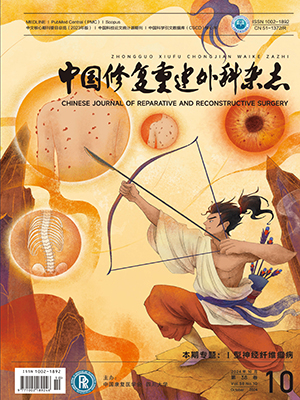Objective To investigate the morphological changes of the proximalfemur and their implication to the total hip arthroplasty in patients with Crowe Ⅱ/Ⅲ developmental dysplasia of the hip (DDH). Methods The experimental gr oup was composed of 15 hips in 14 patients (Crowe Ⅱ, 9 hips; Crowe Ⅲ, 6 hips ) with osteoarthritis secondary to Crowe Ⅱ/Ⅲ DDH (2 males, 12 females; age, 35-61 years). None of the patients had accepted any osteotomy treatment. The control group was composed of 15 normal hips in 15 patients with unilateral DDH (3 males, 12 females; age, 35-57 years). Twelve hips came from the experimental group and the other 3 came from the patients with unilateral Crowe Ⅰ DDH. The femurswere examined with the CT scanning. The following parameters were measured: theheight of the center of the femoral head (HCFH), the isthmus position (IP), theneckshaft angle(NS), the anteversion angle, the canal flare index, and the canal width. Then, the analysis of the data was conducted. Results HCFH and IP in theexperimental group and the control group were 50.1±6.7 mm, 50.1±7.4 mm, and 107.4±21.5 mm, 108.7±18.1 mm,respectively, which had no significant differencebetween the two groups(P gt;0.05). In the experimental group and the control group, the NS were 138.3±10.0° and 126.7±5.7°,the anteversion angles were 36.5±15.9° and 18.8±5.4°, and the canal flare indexes were 4.47±0.40and 5.01±0.43. There was a significant difference between the two groups in the above 3 parameters (P lt;0.05). As for the canal width of the femur, therewasa significant difference in the interior/exterior widths and the anterior/posterior widths at the level of 2 cm above the lesser trochanter and 4 cm belowthe lesser trochanter between the two groups (P lt;0.05); however, there was nosignificant difference in the canal width of the femur at the isthmus between the two groups(P>0.05). Conclusion It is necessary to evaluate the morphology of the proximal femur before the total hip arthroplasty performed in patients with Crowe Ⅱ/Ⅲ DDH. The straight and smaller femoral prosthesis should be chosen and implanted in the proper anteversion position duringoperation.
Citation: LIU Ruiyu,WANG Chunsheng,WANG Kunzheng,et al.. MORPHOLOGICAL CHANGES OF PROXIMAL FEMUR IN PATIENTS WITH CROWE Ⅱ/Ⅲ DEVELOPMENTAL DYSPLASIA OF HIP AND THEIR IMPLICATION TO TOTAL HIP ARTHROPLASTY. Chinese Journal of Reparative and Reconstructive Surgery, 2007, 21(10): 1050-1053. doi: Copy




